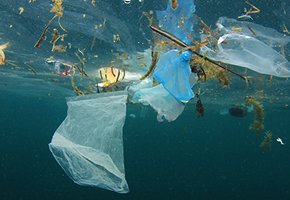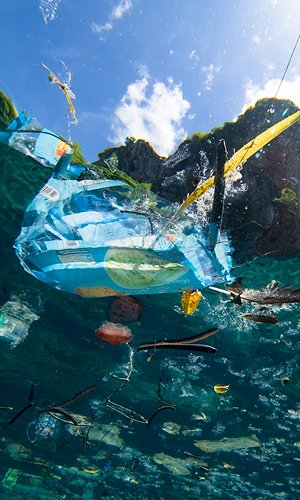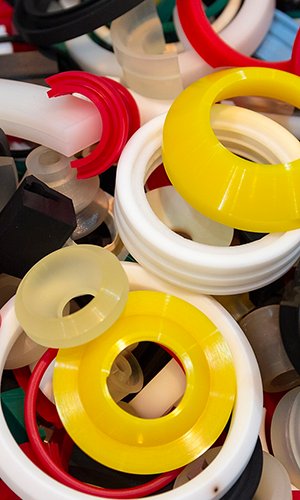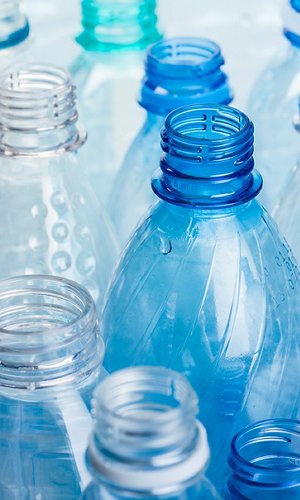Waste, abandoned objects, disposed items, even though we try to ignore them, hide them and shift them, they pervade our life as citizens-consumers. From city streets to natural trails, from industrial areas to beaches, from rivers and streams to the sea, those discarded goods can be found everywhere, and now they have become waste. Modern society, with its disposable goods is increasingly similar to Leonia, the Italian writer Italo Calvino’s invisible city, which refashions itself every day, where there is the constant desire to buy “brand new goods”, and throw away “yesterday’s scraps”, regularly and light-heartedly. Messy waste materials that accumulate on top of old rubbish. At times waste is so fine and small that it cannot be seen with the naked eye. Scraps orbit in space and clutter the sky; in far away seas islands form resorts without stars, made of waste materials. Distances that are not and must not be sufficient for us to remain indifferent, when faced with a problem that becomes bigger and bigger as time passes.
Voice search

Years of plastics

Waste abandoned on the banks of rivers
Looking for shells
Mild temperatures attract a number of people to the sea and as they walk along the seashore, instinctively, curious searchers lower their gaze to see which shells were left behind by the waves, however, as their attention moves towards the horizon, the romantic moment ends, and they realize how much waste they can see there. Cigarette stubs, shoes, bottles, glass, polystyrene, plastic bags and buoys are just a few examples. Any solid materials that are abandoned, discarded or lost in a marine and seaside environment are known as marine debris. This is a form of pollution that is not confined to what one might find when walking on the beach, but which can be found in all the oceans, with different statuses : floating waste that cuts through the waves, other waste that is transported like jellyfish by the currents in water columns, and last, waste on the sea bottom like a suffocating cover.
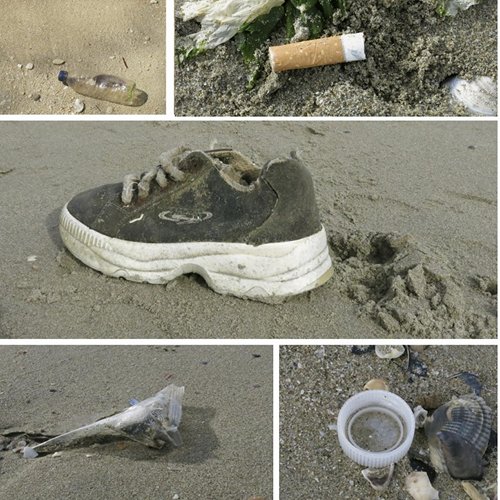
Examples of waste that can be found on a beach (Photo E. Turicchia)
We tend to think that those who are the most responsible for waste in the sea are the fishing industries and the shipping companies . Actually, only 20% of the items found in the sea can be connected directly with high-sea sources, such as fishing ships, cargo ships or pleasure boats. The remaining 80% comes from the mainland, these are waste products that were abandoned on the beaches, industrial and agricultural waste products from bad waste management.
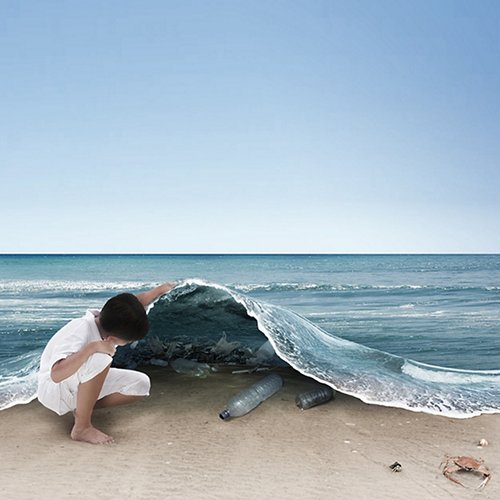
Pollution in the oceans (What lies under – Image F. Rizkiyanto 2011)
Plastic like a diamond
In order to produce a plastic bottle, it takes hours or days, depending on when the production process timer is started. And how long does it take for an item that has been abandoned in the marine environment to degrade? It takes a plastic bottle or bag hundreds of years.
The word plastic is used to describe a series of artificial compounds of different colours, shapes and sizes. In fact, plastic materials are polymers, i.e. long chains of molecules deriving from petroleum. Because of their characteristics, such as malleability, durability, lightness and cheap cost, plastic materials are widely used and greatly appreciated. However their light weight and durable nature, from an environmental point of view, are a threat. The light weight of plastic materials allows them to float and in this way they are transported by currents and by the wind. Their durability instead is tied to the degradation process (for further information, read about the “organic waste”). Floating waste, of a biological origin undergoes biodegradation. Let us imagine we are on a boat and we are eating an apple on a hot summer day. When we have finished this small snack, the apple core might fall accidentally in the sea. The core will travel from 3 to 6 months before it is biodegraded. Instead of biodegrading, plastics of petrochemical origin photodegrade, with the exception of bioplastics, plastics that are not derived from petroleum but from renewable and/or biodegradable raw materials (for example, from maize, wheat or potato starch). Photodegradation is a process in which sunlight breaks the plastic into smaller and smaller pieces, from the size of rice grain to fragments that are so small that a microscope is necessary in order to see them. For example, what happens if clips are left on the washing line? In time, it will be observed that the plastic that they are made of first becomes a lighter shade, and then it breaks due to the effect of the sunlight and the elements. Plastic of sizes below 5 millimetres is called microplastic. There are two main categories of microplastics: small-sized fragments that have detached from larger pieces, such as plastic bottles, due to photodegradation and the mechanical action of waves; and the tiny plastic spheres that are added to cosmetic products for the purpose of a light skin abrasion, or exfoliation, the famous scrubs. Many cosmetic industries have been made aware, in the past years, of this problem and they have banned the use of microspheres in their products.
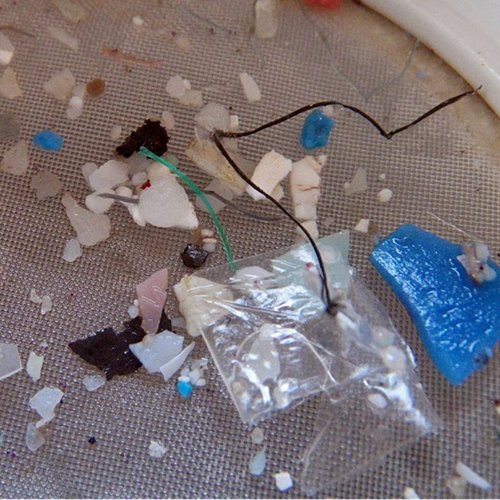
Microplastiche (SEA2 S. Moret)
Therefore, the possibility of floating, together with the long degradation times, make plastics persistent and impacting on the environment. Plastic materials are now present in all the items we use every day, the world production is approximately 200 million tonnes a year. An amount that is difficult to envisage, but if we consider the full load of a lorry is 20 tonnes, 10 million lorries would be necessary to reach the total weight. If we consider a length of 12 meters for each of these lorries, and if we line them up one behind the other, the line would go round the world almost 3 times. What to do with all this plastic? About half of the plastic that is produced, is for the production of disposable items or packaging that is thrown away in less than a year. When they are in the environment, these non-biodegradable bottles and bags require 100 to 1000 years to decompose, depending on their size and the environmental conditions all around them. Every year, 500 to 1000 billion bags are used worldwide, and it is calculated that they are used for an average time of 10-20 minutes. Many countries have banned the use of non-biodegradable disposable bags and they are promoting use of bags made with bioplastics.
The real island
Peter Pan lived on a fictional Island where people ceased to age, and to reach it one would follow the second star to the right and straight on till morning. In the Pacific Ocean, instead, there is a real Island made of waste, divided in two blocks, and there is nothing magical about it. Its presence was supposed in 1988 by NOAA (National Oceanic and Atmospheric Administration), however it was the American oceanographer Charles Moore who first hit against the “Great Pacific Garbage Patch”, on his way back home from a regatta in Hawaii. The island of waste or soup of plastic debris is held together by the North Pacific Subtropical Vortex, a slow ocean current that moves in a clockwise spiral direction between Asia and the United States. In the middle of this vortex, floating waste debris, which are mostly from the mainland, find a relatively calm zone, and aggregate together in a vast area of the Pacific, forming an enormous accumulation of rubbish. The extension of this area is uncertain, it does not have fixed boundaries, and it cannot be spotted from the sky or by the satellites because 80% consists of small plastic particles, microplastics in suspension or floating just below the water surface. Estimates of the size of the island, calculated by collecting samples, vary from a surface that is larger than the Iberian peninsula, to an area twice as large as the United States. Maximum concentrations of surface plastics reach 1 million pieces per square kilometre.
The state of the art
Plastic was invented in the second half of the 19th century, its mass diffusion took place in the 50s, in the last century. The science that studies marine debris, however, is relatively young and an answer has not been found to many questions. In June 2014, the marine ecologist Andreas Cózar and his team completed a fist map of ocean waste. There isn’t only one island of waste, but next to each of the five principal subtropical vortexes, tens of thousands of tonnes of plastic debris have accumulated. The ocean currents, in fact, act as conveyor belts that transport all the waste products towards the nucleus of each respective vortex, where millions of pieces of plastic per square kilometre can be found. Researchers have mapped these islands and have observed millions of pieces of plastic. However they noticed that there was a mismatch in their calculations, there should have been more pieces of plastic floating than those which were observed. Where had the missing plastic gone? This is a question that does not have a reply, however the authors have formulated four hypotheses: they might have been deposited on the shores, they may have become particles of a such microscopic dimensions that they were not collected, they may have been deposited on the ocean bed due to the effect of biofouling (deposit and accumulation of living, single cell or multiple cell organisms, on a surface) or, lastly, they could have been ingested by marine organisms and have therefore become part of the food chain. Also the effect that this plastic will have on the ocean’s ecosystem is an open problem.
Indigestible morsels
Entangling and indigestion are two of the principal types of direct damage to marine organisms caused by marine debris. Entangling and the consequent entrapment can occur by chance or because the animal is attracted by an object as a part of its natural behaviour: curiosity, search of food or shelter. This can lead to defects in the animal’s growth or movement, or can be wounded or be trapped because it is unable to find a way out. Abandoned nets (ghost nets) transported by the currents in intermediate waters or on the ocean-bottom, continue to capture fish and become traps for mammals and marine turtles in search of food.

Abandoned fishing nets can be a threat not only for the fish but also for marine reptiles and mammal
Ingestion of waste products instead occurs because generally the animals confuse these with food. Sea turtles for example love to eat jellyfish. They see them dance delicately in the water and are unable to resist the temptation of such a morsel. But a plastic bag floats just like a jellyfish and can be a potential threat for the life of the turtle. Ingestion of a plastic bag in fact can lead to intestinal occlusion and in the more severe cases, can lead to the turtle’s death.
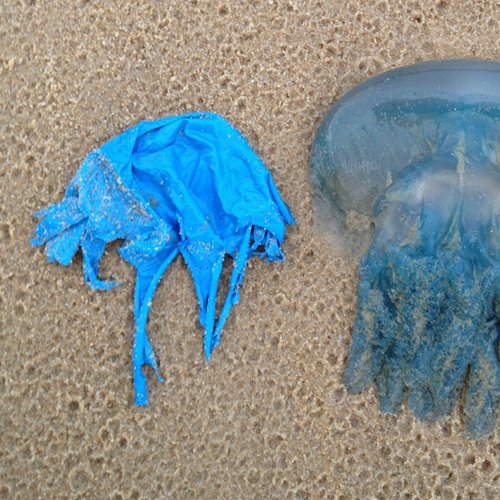
Plastic bags and jellyfish are similar (Photo NOAA)
Furthermore microplastics could be confused with fish larvae, eggs or small crabs. Fish and birds eat them by mistake. Small plastics could accumulate in the digestive tract provoking a false feeling of being full in the animal which is no longer stimulated to look for food, and this consequently leads to malnutrition. Furthermore, small fish are an important link in the food chain. On one hand they involuntarily eat the plastic, and on the other they are a source of nourishment for the larger predators. The plastic is thus transferred in the food chain.
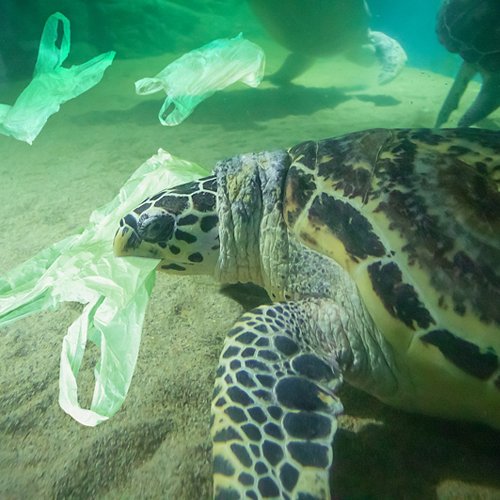
A sea turtle eating plastic.
Further damage to the marine environment and its inhabitants is provoked by the waste that ruins the coastal habitat. Ghost nets can dredge the sea bottom, for example the coral reefs, perturbing the flora and fauna that live there. In shallow water, waste partly prevents the sun rays to penetrate, thus inhibiting the photosynthesis process of plants and algae. Plastic materials can accumulate polluting substances such as PCB (polychlorobiphenyl, persistent pollutants characterized by poor solubility in water) in high concentrations, from 100,000 to 1,000,000 times greater than the levels reported in sea water. Lastly it has been observed that the floating materials are often colonized by other organisms, such as small crustaceans, algae and bacteria. The ocean currents transport them to areas where they were absent, thus becoming vectors of alien species (living species that colonizes a territory different from its own areal).
For further information
Years of plastics for which it is necessary to find solutions and more awareness. It is a challenge for science to develop materials that are less impacting for the environment and new techniques to dispose of the waste: however each one of us, must shed our indifference and must be better informed, and must adopt a virtuous behaviour. Here below are some sites and documents for further information on the topic.
How Does Plastic Pollution Affect Marine Life and How Can We Reduce It?
http://marinedebris.noaa.gov/marinedebris101 (NOAA National Oceanic and Atmospheric Administration, website on the state of marine debris )
http://marinedebris.noaa.gov/sites/default/files/Microplastics.pdf (NOAA National Oceanic and Atmospheric Administration, document on the state of debris in the ocean )
http://www.unep.org/yearbook/2011/pdfs/plastic_debris_in_the_ocean.pdf (UNEP United Nations Environment Programme, document on plastic debris in the ocean)
http://education.nationalgeographic.com/education/encyclopedia/great-pacific-garbage-patch/?ar_a=1 (National Geographic Education, slides and curiosities about the problem of microplastics )
http://www.pnas.org/content/111/28/10239.full (Article by Còzar et al., PNAS, 2014)
http://ec.europa.eu/environment/marine/good-environmental-status/descriptor-10/index_en.htm (EU European Union, EU document on waste )
http://alejandroplasencia.com/2014/08/08/remora/ (Video and information about Remora system biodegradable fishing nets with tracking tags)
http://www.life-ghost.eu/index.php/it/ (Ghost project, on the impacts of fishing equipment abandoned in the Northern Adriatic sea)
http://www.greenreport.it/news/aree-protette-e-biodiversita/microplastica-nel-tirreno-concentrazioni-simili-quelle-delle-aree-contaminate-pacifico/#prettyPhoto (Greenreport.it article on the Italian and French expedition to the Sanctuary for large and small Cetaceans )
Edited by Eva Turicchia


